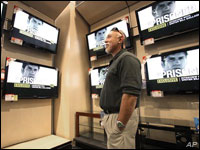Today’s consumers are more connected than ever with mobile devices in hand, while retailers have long focused on better engaging with consumers. Some brands have enjoyed early wins through effective direct digital marketing.

Mobile solves many problems, with its high reach and in-the-moment communication. A well-designed app can place flashy content in the hands of the consumer. SMS provides the consumer with valuable tidbits of information. SMS and apps can be effective ways for retailers to connect with consumers on a mobile device; however, for technology and adoption reasons, these tactics can fall short of providing the information consumers need to make a buying decision while they’re still in the store.
The good news is that an emerging technology in direct digital marketing — 2D tagging — can connect people with relevant information instantly, effectively engaging them while that precious purchase-decision window is open.
For retailers and manufacturers, 2D tagging closes the gap between online and in-store shopping experiences, making it easier than ever for consumer to engage with a brand. Properly placed 2D tagging technology directly enhances the retail experience by giving consumers instant access to specific, relevant information they want — at the moment they’re engaged in a buying decision — in one simple step, increasing conversions.
How It Works
Simply put, “2D tag” (often used synonymously with QR, 2D Barcode) is a term to describe a two-dimensional bar code that provides a link to an online experience when scanned through a mobile device. Each 2D tag is encoded with specific information such as URL, product or contact information. Most 2D tags require a user-friendly downloaded software application that turns a mobile device’s camera lens into an optical scanner. When the mobile device is aimed at the tag with the app activated, the software scans and decodes the information, and then links the mobile browser to a URL or microsite, for example.
One compelling trait of 2D tagging, as seen in the following example, is its ease of use. With a simple scan, the consumer has all the information needed to make an informed big-ticket purchase. Also, sales staff have the information they need to better educate the consumer and close a sale. While this activity may seem a bit foreign at first, regular exposure to it and wider adoption by brands (and by various media in the U.S.) has allowed greater recognition by today’s consumers. As they become more familiar with the technology, they will want to use it more often.
2D Tagging Example
Joe, who uses a mobile device, walks into a store in search of a new printer for his office. He sees the product he needs but wants more information. Because the product (or its display) features a 2D tag, he simply scans the tag with his mobile device (loaded with its appropriate app), and is instantly taken to a mobile microsite designed for the shopping experience by the manufacturer.
In a best-case scenario, the mobile site includes an overview of the product, its features, specifications, real customer reviews and ratings, service details — even videos. So instead of leaving the retail location to do more research on printers (or shop competitors), Joe quickly accesses the information he needs to make a buying decision on the spot.
The 2D tagging technology removes barriers in the buying process. Online connects with offline through 2D tagging to enhance the retail experience and increase sales for the retailer. By implementing the 2D tag solution, the manufacturer is able to easily connect with and engage with consumers.
In the end, Joe is much more likely to recommend the store and the product purchased because of the unique, useful, in-store support that was made available to him through his mobile device.
The diversity of major brands currently using these codes today speaks volumes about its mainstream promise, as well as the customer’s desire to have these experiences. For example, Calvin Klein uses them on outdoor signage.
Other Advantages
The advantages of 2D tagging go even further by placing effective sales tools in the hands of associates, without necessitating investments in excessive training and expensive sales materials. Information accessible through 2D tagging ensures sales associates have instant answers, providing a higher level of customer service. Instead of wearing a blank expression when asked about specific product details, associates can instead access information via 2D tagging to efficiently serve the customer with confidence to close the sale.
By incorporating 2D tagging into your cross-channel direct digital marketing strategy, you offer consumers a seamless way to further engage with a brand and open up all of these options and more.
From a consumer standpoint, 2D tagging solutions save time by reducing the number of steps required to receive information. Scanning a 2D tag offers instant gratification, and it is much more efficient than having to type a text and wait for a response.
From a business standpoint, the fewer steps involved, the smaller the likelihood of losing opportunities to engage with consumers at their peak moments of receptivity. Plus, 2D tagging often comes with less overhead than a traditional SMS campaign.
Once the appropriate software is downloaded, consumers merely position their phone in front of a 2D tag and are instantly rewarded with information (in the form of mobile Web content, a file to download, or even an automatically generated SMS message) that engages them more deeply. Manufacturers and retailers can provide better information cost-effectively, without the expense of kiosks, displays, signage or print materials.
Get Ready?
The trend toward making everything interactive with these codes is readily apparent in Asian cultures, where it is not uncommon to use mobile devices to accomplish most activities the U.S. relegates either to credit cards or traditional and PC-based media. QR technology was invented in Japan so if you were to travel there, for example, you could rely almost solely on 2D technology and your mobile device, using it to find out how many calories are in your McDonald’s #5 (tag printed on the packaging); to get directions to the doctor’s office in an building (codes used on directional signage); to watch a video about how the expensive t-shirt you purchased was made (just scan the price tag label); or even enter yourself to win a trip to Tokyo Disneyland from a scan on a public transportation poster advertisement.
The mobile landscape is evolving at a rapid pace. 2D tagging solutions are already widely used in Asia. Adoption in the U.S. has been trending toward an explosion, requiring device-optimized mobile websites as an important aspect of cross-channel marketing for retail applications seeking a more robust and effective direct digital marketing strategy.
Brian Deagan is cofounder and CEO of Knotice, a direct digital marketing solutions company. He can be reached at bdeagan@knotice.com. More information on Knotice is available at the company’s blog.






































Social Media
See all Social Media